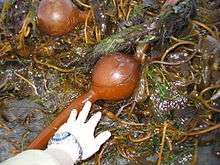Pneumatocyst

In phycology, a pneumatocyst is a floating structure that contains gas found on brown seaweed. A seaweed's thallus may have more than one. They provide buoyancy to lift the blades toward the surface, allowing them to receive more sunlight for photosynthesis.
The proportion of gases in the pneumatocysts varies depending on the physiological status of the alga and the partial pressure of gases in the surrounding air or water.[1] The pneumatocyst can hold O2, CO2, N2,[1] and CO.[2]

References
- 1 2 Thiel, M.; L. Gutow (2005). "The Ecology of rafting in the marine environment". Oceanography and Marine Biology: An Annual Review. The Floating Substrata. 42: 181–264.
- ↑ Foreman, Ronald E. (1976). "Physiological aspects of carbon monoxide production by the brown alga Nereocystis luetkeana". Botany. 54 (3-4): 352–360. doi:10.1139/b76-032. ISSN 1916-2804.
Further reading
Hoover, Jason M.; Wenger, Doris E.; Eckel, Laurence J.; Krauss, William E. (September 2011). "Cervical pneumatocyst case report". Journal of Neurosurgery-spine. 15 (3): 332. doi:10.3171/2011.5.SPINE10627.
Plouguerne, Erwan; Cesconetto, Criscia; Cruz, Camila P.; Pereira, Renato C.; da Gama, Bernardo A. P. (December 2012). "Within-thallus variation in polyphenolic content and antifouling activity in Sargassum vulgare". Journal of Applied Phycology. 24 (6): 1629. doi:10.1007/s10811-012-9826-0.